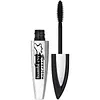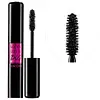What's inside
What's inside
 Key Ingredients
Key Ingredients

 Benefits
Benefits

 Concerns
Concerns

 Ingredients Side-by-side
Ingredients Side-by-side

Water
Skin ConditioningParaffin
PerfumingPotassium Cetyl Phosphate
EmulsifyingAcrylates Copolymer
Cera Alba
EmollientCopernicia Cerifera Cera
EmollientEthylene/Acrylic Acid Copolymer
Emulsion StabilisingSteareth-2
EmulsifyingCetyl Alcohol
EmollientPhenoxyethanol
PreservativeHydroxyethylcellulose
Emulsion StabilisingAcacia Senegal Gum
MaskingEthylenediamine/Stearyl Dimer Dilinoleate Copolymer
Skin ConditioningSodium Dehydroacetate
PreservativeCaprylyl Glycol
EmollientHydrogenated Jojoba Oil
AbrasiveHydrogenated Palm Oil
EmollientPropylene Glycol
HumectantDisodium EDTA
Pentaerythrityl Tetraisostearate
EmollientSodium Hyaluronate
HumectantOleamide
2-Oleamido-1,3-Octadecanediol
Skin ConditioningRayon
Panthenol
Skin ConditioningSilica
AbrasiveLaureth-21
CleansingSoluble Collagen
HumectantSilica Dimethyl Silylate
EmollientTrisodium EDTA
Butylene Glycol
HumectantPentaerythrityl Tetra-Di-T-Butyl Hydroxyhydrocinnamate
AntioxidantPotassium Sorbate
PreservativeSodium Chondroitin Sulfate
Skin ConditioningAtelocollagen
Skin ConditioningBHT
AntioxidantHexylene Glycol
EmulsifyingCI 77491
Cosmetic ColorantCI 77492
Cosmetic ColorantCI 77499
Cosmetic ColorantCI 77891
Cosmetic ColorantCI 77007
Cosmetic ColorantWater, Paraffin, Potassium Cetyl Phosphate, Acrylates Copolymer, Cera Alba, Copernicia Cerifera Cera, Ethylene/Acrylic Acid Copolymer, Steareth-2, Cetyl Alcohol, Phenoxyethanol, Hydroxyethylcellulose, Acacia Senegal Gum, Ethylenediamine/Stearyl Dimer Dilinoleate Copolymer, Sodium Dehydroacetate, Caprylyl Glycol, Hydrogenated Jojoba Oil, Hydrogenated Palm Oil, Propylene Glycol, Disodium EDTA, Pentaerythrityl Tetraisostearate, Sodium Hyaluronate, Oleamide, 2-Oleamido-1,3-Octadecanediol, Rayon, Panthenol, Silica, Laureth-21, Soluble Collagen, Silica Dimethyl Silylate, Trisodium EDTA, Butylene Glycol, Pentaerythrityl Tetra-Di-T-Butyl Hydroxyhydrocinnamate, Potassium Sorbate, Sodium Chondroitin Sulfate, Atelocollagen, BHT, Hexylene Glycol, CI 77491, CI 77492, CI 77499, CI 77891, CI 77007
Water
Skin ConditioningParaffin
PerfumingPotassium Cetyl Phosphate
EmulsifyingCopernicia Cerifera Cera
EmollientEthylene/Acrylic Acid Copolymer
Emulsion StabilisingStyrene/Acrylates/Ammonium Methacrylate Copolymer
Cera Alba
EmollientSynthetic Beeswax
Emulsion StabilisingBis-Diglyceryl Polyacyladipate-2
EmollientPolybutene
Cetyl Alcohol
EmollientSteareth-20
CleansingGlyceryl Dibehenate
EmollientSteareth-2
EmulsifyingC12-13 Pareth-23
CleansingC12-13 Pareth-3
EmulsifyingTribehenin
EmollientAcacia Senegal Gum
MaskingGlyceryl Behenate
EmollientSodium Laureth Sulfate
CleansingSilica
AbrasiveDivinyldimethicone/Dimethicone Copolymer
Disodium EDTA
Hydrogenated Jojoba Oil
AbrasiveHydrogenated Palm Oil
EmollientHydroxyethylcellulose
Emulsion StabilisingCaprylyl Glycol
EmollientTetrasodium EDTA
Ethylenediamine/Stearyl Dimer Dilinoleate Copolymer
Skin ConditioningButylene Glycol
HumectantBHT
AntioxidantPentaerythrityl Tetra-Di-T-Butyl Hydroxyhydrocinnamate
AntioxidantPotassium Sorbate
PreservativeSodium Dehydroacetate
PreservativePhenoxyethanol
PreservativeWater, Paraffin, Potassium Cetyl Phosphate, Copernicia Cerifera Cera, Ethylene/Acrylic Acid Copolymer, Styrene/Acrylates/Ammonium Methacrylate Copolymer, Cera Alba, Synthetic Beeswax, Bis-Diglyceryl Polyacyladipate-2, Polybutene, Cetyl Alcohol, Steareth-20, Glyceryl Dibehenate, Steareth-2, C12-13 Pareth-23, C12-13 Pareth-3, Tribehenin, Acacia Senegal Gum, Glyceryl Behenate, Sodium Laureth Sulfate, Silica, Divinyldimethicone/Dimethicone Copolymer, Disodium EDTA, Hydrogenated Jojoba Oil, Hydrogenated Palm Oil, Hydroxyethylcellulose, Caprylyl Glycol, Tetrasodium EDTA, Ethylenediamine/Stearyl Dimer Dilinoleate Copolymer, Butylene Glycol, BHT, Pentaerythrityl Tetra-Di-T-Butyl Hydroxyhydrocinnamate, Potassium Sorbate, Sodium Dehydroacetate, Phenoxyethanol
 Reviews
Reviews

Ingredients Explained
These ingredients are found in both products.
Ingredients higher up in an ingredient list are typically present in a larger amount.
Acacia Senegal Gum has skin soothing, thickening, and formulation stabilizing properties. It comes from the Acacia tree that is native to sub-Saharan Africa.
BHT is a synthetic antioxidant and preservative.
As an antioxidant, it helps your body fight off free-radicals. Free-radicals are molecules that may damage your skin cells.
As a preservative, it is used to stabilize products and prevent them from degrading. Specifically, BHT prevents degradation from oxidation.
The concerns related to BHT come from oral studies; this ingredient is currently allowed for use by both the FDA and EU.
However, it was recently restricted for use in the UK as of April 2024.
Learn more about BHTButylene Glycol (or BG) is used within cosmetic products for a few different reasons:
Overall, Butylene Glycol is a safe and well-rounded ingredient that works well with other ingredients.
Though this ingredient works well with most skin types, some people with sensitive skin may experience a reaction such as allergic rashes, closed comedones, or itchiness.
Learn more about Butylene GlycolCaprylyl Glycol is a humectant and emollient, meaning it attracts and preserves moisture.
It is a common ingredient in many products, especially those designed to hydrate skin. The primary benefits are retaining moisture, skin softening, and promoting a healthy skin barrier.
Though Caprylyl Glycol is an alcohol derived from fatty acids, it is not the kind that can dry out skin.
This ingredient is also used as a preservative to extend the life of products. It has slight antimicrobial properties.
Learn more about Caprylyl GlycolCera alba is beeswax, or the wax used by bees to make honeycombs. It is a texture-enhancer and emollient. A study from 2003 found beeswax to be a stronger emollient than ingredients such as petroleum jelly.
As an emollient, beeswax helps hydrate the skin by creating a barrier on top. This barrier traps moisture in.
Emulsifiers help prevent ingredients from separating. This helps create consistent texture.
The structure of beeswax is mainly long-chain alcohols and the esters of fatty acids.
There are three types of beeswax: yellow, white, and absolute. Yellow is pure beeswax taken from the honeycomb. White beeswax is created by filtering or bleaching yellow beeswax. Absolute beeswax is created by treating beeswax with alcohol. Beeswax used in cosmetics are purified.
Beeswax has been used throughout history and even in prehistoric times. Some common uses for beeswax still used today are making candles, as a waterproofing agent, and polish for leather.
Learn more about Cera AlbaCetyl Alcohol is a fatty alcohol. Fatty Alcohols are most often used as an emollient or to thicken a product.
Its main roles are:
Though it has "alcohol" in the name, it is not related to denatured alcohol or ethyl alcohol.
The FDA allows products labeled "alcohol-free" to have fatty alcohols.
Learn more about Cetyl AlcoholThis ingredient comes from a palm tree native to Brazil. This ingredient is used to thicken texture and leaves behind a film when applied.
Disodium EDTA plays a role in making products more stable by aiding other preservatives.
It is a chelating agent, meaning it neutralizes metal ions that may be found in a product.
Disodium EDTA is a salt of edetic acid and is found to be safe in cosmetic ingredients.
Learn more about Disodium EDTAWe don't have a description for Ethylene/Acrylic Acid Copolymer yet.
Ethylenediamine/Stearyl Dimer Dilinoleate Copolymer isn't fungal acne safe.
Hydrogenated Jojoba Oil is created from the process of converting jojoba oil to a solid or semi-solid. Jojoba oil has occlusive and emollient properties, making it a great hydrator.
Due to the solid structure of this ingredient, it provides abrasive or exfoliating properties.
This ingredient may not be fungal acne safe.
Learn more about Hydrogenated Jojoba OilHydrogenated Palm Oil is an oil and isn't fungal acne safe.
Hydroxyethylcellulose is used to improve the texture of products. It is created from a chemical reaction involving ethylene oxide and alkali-cellulose. Cellulose is a sugar found in plant cell walls and help give plants structure.
This ingredient helps stabilize products by preventing ingredients from separating. It can also help thicken the texture of a product.
This ingredient can also be found in pill medicines to help our bodies digest other ingredients.
Learn more about HydroxyethylcelluloseParaffin is a solid created from petroleum. The term 'paraffin' can also refer to either
petroleum jelly or mineral oil.
It has natural occlusive properties which can worsen oily skin. Due to its petrolatum base, this ingredient is not fungal-acne safe.
Pentaerythrityl Tetra-Di-T-Butyl Hydroxyhydrocinnamate (long name, huh?) is a synthetic antioxidant.
It is used to help stabilize other antioxidants or prevent the color from changing in a product.
As an antioxidant, it helps fight free-radical molecules. Free-radical molecules are capable of damaging our cells and other genetic material. Thus, antioxidants may reduce the signs of aging.
This ingredient is oil-soluble.
Learn more about Pentaerythrityl Tetra-Di-T-Butyl HydroxyhydrocinnamatePhenoxyethanol is a preservative that has germicide, antimicrobial, and aromatic properties. Studies show that phenoxyethanol can prevent microbial growth. By itself, it has a scent that is similar to that of a rose.
It's often used in formulations along with Caprylyl Glycol to preserve the shelf life of products.
Potassium Cetyl Phosphate is the potassium salt of a mixture. This mixture consists of the esters from phosphoricacid and cetyl alcohol.
Potassium Cetyl Phosphate is an emulsifier and cleansing agent. Emulsifiers help stabilize a product. It does this by preventing certain ingredients from separating.
As a cleansing agent, Potassium Cetyl Phosphate helps gather oils, dirts, and pollutants from your skin. This makes it easier to rinse them away with water.
Learn more about Potassium Cetyl PhosphatePotassium Sorbate is a preservative used to prevent yeast and mold in products. It is commonly found in both cosmetic and food products.
This ingredient comes from potassium salt derived from sorbic acid. Sorbic acid is a natural antibiotic and effective against fungus.
Both potassium sorbate and sorbic acid can be found in baked goods, cheeses, dried meats, dried fruit, ice cream, pickles, wine, yogurt, and more.
You'll often find this ingredient used with other preservatives.
Learn more about Potassium SorbateSilica, also known as silicon dioxide, is a naturally occurring mineral. It is used as a fine, spherical, and porous powder in cosmetics.
Though it has exfoliant properties, the function of silica varies depending on the product.
The unique structure of silica enhances the spreadability and adds smoothness, making it a great texture enhancer.
It is also used as an active carrier, emulsifier, and mattifier due to its ability to absorb excess oil.
In some products, tiny microneedles called spicules are made from silica or hydrolyzed sponge. When you rub them in, they lightly polish away dead skin layers and enhance the penetration of active ingredients.
Learn more about SilicaThis ingredient is a preservative with antimicrobial properties. It is the sodium salt of dehydroacetic acid.
It is especially effective at preventing bacterial and fungal growth in low concentrations.
Steareth-2 is a waxy compound used to emulsify ingredients. It is created from polyethylene glycol and stearyl alcohol.
The 2 stands for the number of ethylene oxide units used to create this ingredient.
Water. It's the most common cosmetic ingredient of all. You'll usually see it at the top of ingredient lists, meaning that it makes up the largest part of the product.
So why is it so popular? Water most often acts as a solvent - this means that it helps dissolve other ingredients into the formulation.
You'll also recognize water as that liquid we all need to stay alive. If you see this, drink a glass of water. Stay hydrated!
Learn more about Water